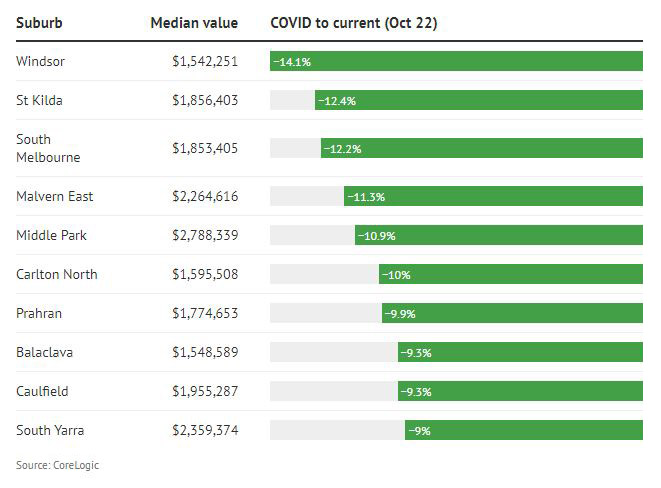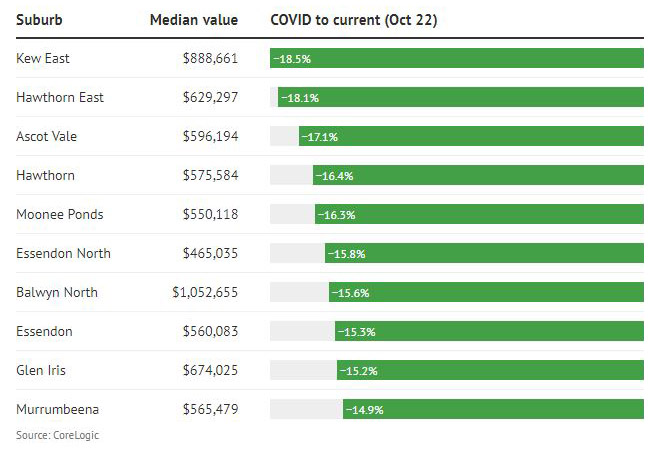Melbourne's 10 best and worst performing suburbs, and where to buy in 2023
The gap between the best and worst performing Melbourne suburbs for price growth is huge but what will 2023 present as the best investment options?
Property investment opportunities still exist in Melbourne’s declining market but price fluctuations between the best and worst performing suburbs are immense.
For houses, the gulf is evident in the downwards trajectory of Windsor, which fell more than 14 per cent over a year, and Keilor East that soared 20 per cent in the same period.
It was a similar story in the unit market, with a 34 per cent difference between the best and worst performing suburbs for property price movements. Doncaster East unit owners enjoyed gains of 15.6 per cent in 12 months, compared to Kew East’s owners who endured an 18.5 per cent drop in values.
Timing the market cycle to buy at the best price is always a tricky proposition but if Westpac forecasts are to be believed, Melbourne presents its own degree of difficulty.
The Victorian capital was expected to experience a further 10 per cent drop in dwelling values in 2023, with Westpac noting it was “more sensitive to rate hikes and migration slowdown.”
That scenario would result in the city’s median house price falling $79,834 this year, from $997,928, followed by another $91,809 decline in 2023. That would equate to a $171,644 decline over two years to $826,284.
Top 10 suburbs for unit price growth
| Suburb | 12 months to Sep-22 quarter | Annual change | Days on market - Sep 2022 |
|---|---|---|---|
| Doncaster East | $1,017,500 | 15.6% | 40 |
| Frankston | $555,000 | 15.4% | 27 |
| Brighton | $1,288,500 | 12.0% | 38 |
| Bundoora | $500,500 | 10.0% | 55 |
| Malvern | $819,000 | 9.2% | 33.5 |
| Langwarrin | $600,000 | 9.1% | 18.5 |
| Noble Park | $570,000 | 8.1% | 30 |
| Brighton East | $1,562,500 | 7.5% | 27 |
| Brunswick East | $639,000 | 6.1% | 33.5 |
| Croydon | $675,000 | 6.0% | 26 |
Source: reiv.com.au
Top 10 suburbs for house price growth
| Suburb | 12 months to Sep-22 quarter | Annual change | Days on market - Sep 2022 |
|---|---|---|---|
| Keilor East | $1,100,000 | 20.2% | 44 |
| Rosebud | $896,500 | 18.7% | 17 |
| Narre Warren South | $818,000 | 18.0% | 29 |
| Caroline Springs | $772,500 | 17.0% | 28 |
| Mount Martha | $1,806,900 | 16.6% | 36 |
| Beaumaris | $2,205,000 | 16.4% | 42.5 |
| Fraser Rise | $730,000 | 14.8% | 31 |
| Mount Evelyn | $900,000 | 14.6% | 18 |
| Wollert | $710,000 | 14.5% | 36 |
| Clyde North | $750,000 | 13.3% | 27 |
Source: reiv.com.au
Jim Malamatinas, Head Buyers Agent and Director of A Game Property Advisory, told API Magazine that the more affordable suburbs were now priced at a level that made them tempting to investors and first-home buyers.
He identified suburbs with widely differing market performance over the past 12 months as presenting investment value in 2023.
Mernda and South Morang, in Melbourne’s outer north, only slipped 2 per cent in value, while to the east of the city Kilsyth and Ringwood East fell 15 per cent, but each represented market value, Mr Malamatinas said.
“The price falls we have seen in recent months will not last forever, and these suburbs are showing early indicators that market conditions could be levelling out, meaning the price drops could end soon.
“At some point buyers will realise that month-on-month price falls may be ending, with these suburbs having a particularly high likelihood of seeing demand from multiple buying groups.”
While they might have a few more months of volatility, Mr Malamatinas believes this is this could be the best time to buy a property.
“The pent-up demand from all the ‘wait and see’ cohort will only be exacerbated with the commencement of government planned record levels of migration in 2023.
“Rental demand is at its all-time high, with the worst rental crisis in almost 20 years and Melbourne tenants are relying on private landlords to help solve the problem as soon as possible,” he said.
Maidstone is the cheapest market for houses within 10 kilometres of the Melbourne CBD, with a median price of $829,000.
Buyers can also find a house for less than $1 million in West Footscray and Coburg North, where prices are sitting at $930,000 and $956,000, respectively.
Melbourne’s inner urban, north, west and north-east dominated the most affordable unit markets in the city.
Apartments in Carlton, Flemington, West Footscray, Maidstone and Footscray are currently priced below $500,000, and worth less than $600,000 on average in Richmond, Brunswick and St Kilda.
Shying away from building
While many buyers were being driven by higher interest rates to outer suburbs, there are 23 suburbs within 10 kilometres of Melbourne’s CBD where units are worth $600,000 or less.
Nicola Powell, Domain’s chief of economics and research said, “Realistically, rising interest rates and inflation has meant that city living is somewhat out of reach for many Australians, however, there are many affordable areas close to the city if buyers are willing to be flexible on their inner-city location and property type.”
Biggest falls in Melbourne house median values

Biggest falls in Melbourne unit median values

Speaking to API Magazine, Fletchers Executive Chairman, Jeremy Desmier, buying new was preferred over building by more and more people.
“New or near new homes and townhouses are outperforming most other market segments in the eastern suburbs,” Mr Desmier said.
“I attribute this to the massive increase in building costs since Covid, estimated to be 30-40 per cent, so many people have abandoned plans to build a new home with a bespoke or volume builder.
“Others have done same where they had invested in architectural plans for major extensions, in favour of buying something new or near new, ready to move into with nothing to spend.
“Land value propositions that were extremely hot property 12 months ago have probably seen the biggest downwards adjustment.”
Melbourne home value declines eased last month by another 0.8 per cent but Mr Desmier said further price falls were likely.
“I believe we will see further easing of prices until interest rates stabilise - perhaps a couple of RBA meetings where they leave interest rates the same with no increase or even announce a decrease.
“This would create some confidence that rates have reached a ceiling.
“The other factor is lack of supply, in the inner east especially, which may focus demand and stablise or even increase prices.”
He said Fletchers’ outer-eastern offices were still seeing substantial turnover and buyer activity, compared to the Inner East (City if Boroondara and City of Stonnington) where supply has decreased dramatically.
“The lack of supply is helping to stabilise pricing, in spite of continued interest rate rises.
“Where the market heads in 2023 will be driven largely by buyer confidence early in the year.
“We should see some pent-up demand after the traditionally slower months of December and January, so if there is a bit more volume available February and March 2023, the level of competition and price trends I believe will set the tone for the following six months.”




















